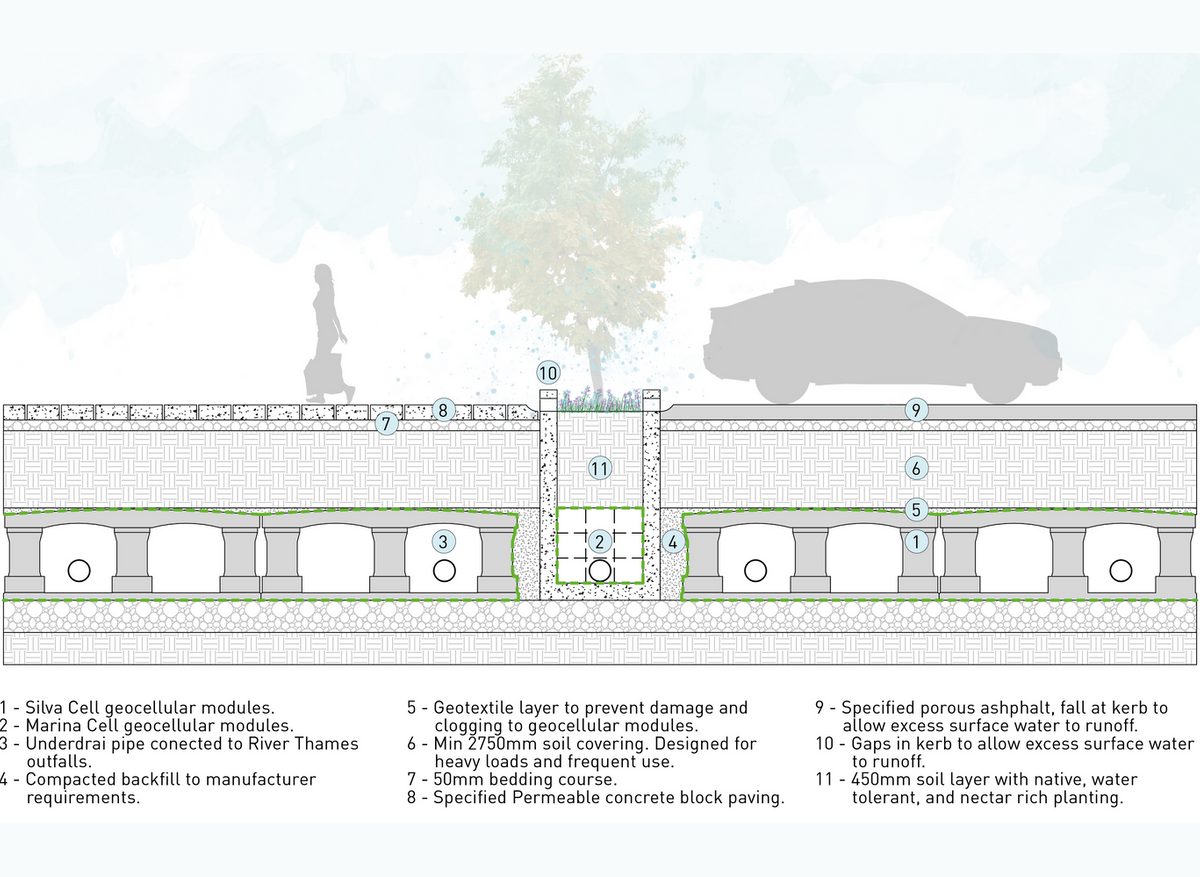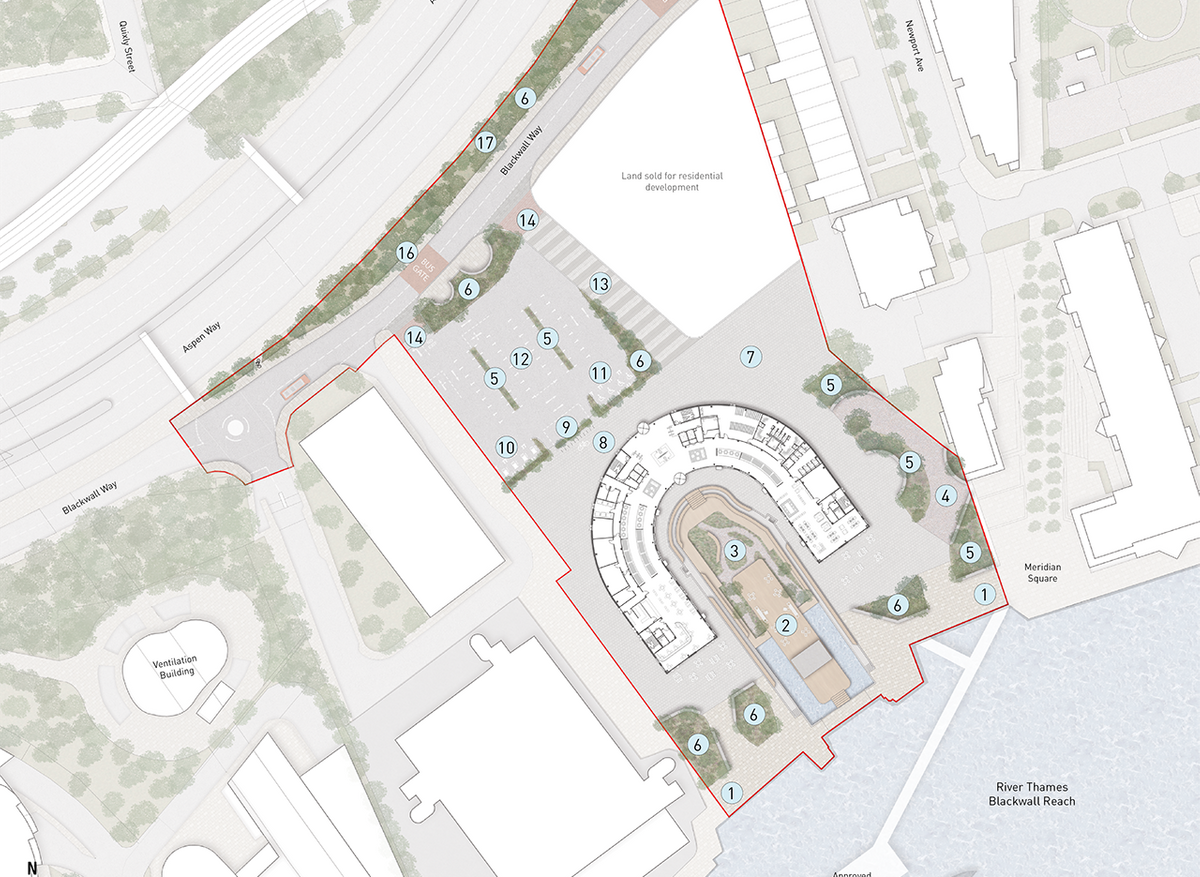Commended | Harnessing Sustainable Urban Drainage Systems (SuDS) for Surface Water Management
Braydon O'Donnell, Nottingham Trent University
Flooding is the most serious natural hazard faced in the United Kingdom, with damages estimated at £500 million to £1 billionannually. Urban areas are particularly vulnerable because population growth and high-density developments have led to the degradation of naturally permeable landscapes. The London Borough of Tower Hamlets is emblematic of these challenges: it is the most densely populated area in the UK and has experienced a 22% population increase over the last decade. Limited open green space, combined with its location on the Thames riverfront within Flood Zones 3a and 3b, has made the projects site highly susceptible to fluvial flooding. The research project, Harnessing Sustainable Urban Drainage Systems [SuDS] for Surface Water Management, explores how SuDS can minimise surface water runoff and water pollution. SuDS offer a nature-based approach to managing surface water runoff by mimicking natural water management processes.
Methodology
The study followed a mixed-methods methodology, combining the benefits of both quanitative and qualiative approaches, resulting in a more comprehensive understanding and verifiable results. Phase 1 critically evaluated existing literature, research, and local SuDS guidance to identify suitable SuDS interventions for reducing surface water runoff and water pollution. From this, 3 suitable interventions emerged: permeable paving, bioretention systems/ rain gardens, and vegetated swales. A secondary outcome of the literature review was the decision to adopt the Flood Estimation Handbook [FEHi method for caluclating the sites Mean Annual Flood [OBAR]. which was preferred over the older IH124 algorithm, as FEH was shown to be statisically more reliable, incorporating real-time weather conditions, hydrology, and soil data.
Phase 2 employed the UKSuDS "Greenfield Runoff Rate Estimation" tool to establish the sites baseline conditions. Investigation revealed loamy and clayey soils with naturally high groundwater, characteristics that increase susceptibility to pollution which, as per Tower Hamlets SuDS Guidance, render infiltration based SuDS unsiutable, likely due to the sites industrial history.
The 3rd phase brought these findings into practice using the Storm Water Management Model [SWMM]. developed by the U.S.Environmental Protection Agency. Using SWMM simulations, the author assessed the performance of the shortlisted SuDSunder both 1-in-25-year and 1- in-100-year storm scenarios, incorporating a 40% climate change allowance to reflect future conditions. The 1 in 25-year event evaluates performance in moderate, frequent storms, meeting Tower Hamlets requirement for no surface flooding within such conditions. The 1 in 100-year event evaluates long-term effectiveness against extreme weather, as required by the Environmental Agency and recommended by Tower Hamlets SuDS Guidance. Both storms were modelled as 6-hour events broken into 15-minute intervals. Although Tower Hamlets recommend a 2-hour storm, the author simulated 6-hours to better capture peak runoff and reflect worst-case conditions for assessing SuDS performance. Permeable paving, bioretention systems, and swales were modelled individually and in combination, alongside a biodiverse blue roof which was included toreflect Tower Hamlets encouragement for their use due to widespread applicability.
Findings
Individually, permeable paving achieved the highest reduction in runoff at 54.4%, largely due to its extensive site coverage. Bioretention systems, whilst showing lower retention rates across the whole site, outperformed all other interventions when measured by retention per square metre, underscoring their value in space constrained urban contexts. When all four interventions were combined, runoff was reduced by 61.8% in a 1-in-25-year storm and 61.2% in a 1-in-100-year storm. These findings confirmed the hypothesis: a management train is far more effective than isolated measures.
Beyond the retention rates and pollution reduction capabilities of SuDS, this study also evaluated addition benefits of SuDS. Rain gardens and swales introduce much needed biodiversity, offering habitats for pollinators and native species. Blue roofs, meanwhile, support rainwater harvesting strategies and help reduce air pollution. Therefore, showing Su OS are not onlybeneficial for reducing surface water flooding, but also broader ecological and social value.
Limitations
The research is careful to acknowledge its limitations, however. SWMM, while a powerful tool, cannot account for the long-term maintenance requirements that underpin real world performance. Permeable paving, for example, demands regular cleaning to avoid clogging, while rain gardens and swales require ongoing care to sustain vegetation. Costs were also excluded from the modelling, yet capital and maintenance budgets remain crucial considerations for clients in real world applications. These limitations point to the need for further research into lifecycle cost benefit analysis and the role of maintenance in sustaining system effectiveness over time.
Conclusion
In conclusion, the study demonstrates that combining permeable paving, bioretention rain gardens, vegetated swales, and blue roofs offers the most effective strategy for the project site. Such an integrated approach achieves significant reductions in runoff while simultaneously delivering biodiversity, ecological value, and much-needed open green space.

-

-
The Judges commended Braydon's work as a strong and well-structured study that engages with one of the most pressing issues in the built environment today. From the outset, the report set out a clear aim and hypothesis, supported by a concise abstract that provided readers with a strong overview of the study. Overall, the Judges described Braydon's submission as a strong, insightful and impactful piece of research with clear practical application.
Judges' comments
Student Report of the Year
